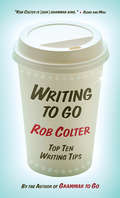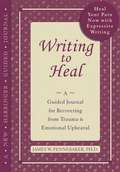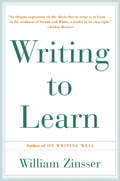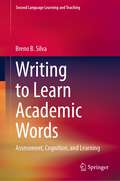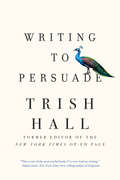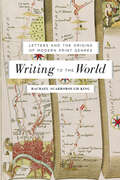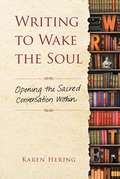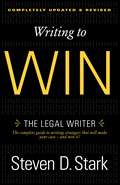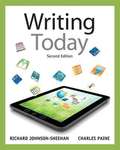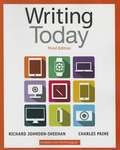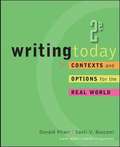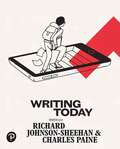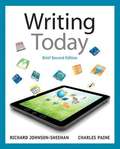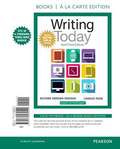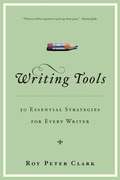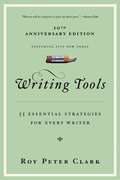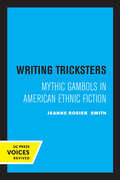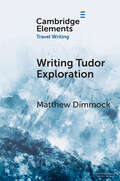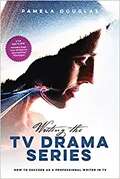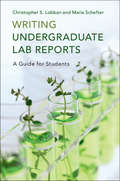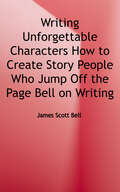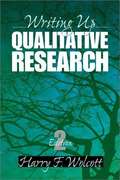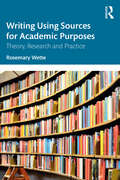- Table View
- List View
Writing to Go: Top Ten Writing Tips
by Rob ColterIn today's fast-paced world of e-mail and instant messaging, clear writing is more important than ever. In Writing to Go, bestselling author Rob Colter takes us through the writing process in ten easy steps. This book is packed with precise and practical information delivered in a down-to-earth tone with often humorous examples. Everywhere from the classroom to the office, Colter's Top Ten Writing Tips will give you the confidence to write with greater speed and impact, covering everything from knowing your purpose and audience, to selecting your format, organizing your points, and writing clearly and effectively.
Writing to Heal: A Guided Journal for Recovering from Trauma and Emotional Upheaval
by James W. PennebakerThis book takes readers through a series of guided writing exercises that help them explore their feelings about difficult experiences. Each chapter begins with an introduction that explains how to proceed with journal exercises and what they are structured to help accomplish. The exercises leave readers with a strong sense of their value in the world.
Writing to Learn
by William ZinsserThis is an essential book for everyone who wants to write clearly about any subject and use writing as a means of learning.
Writing to Learn Academic Words: Assessment, Cognition, and Learning (Second Language Learning and Teaching)
by Breno B. SilvaThis book highlights the importance of English academic vocabulary for success at university and explores written tasks as effective pedagogical tools to promote the acquisition of academic words. The book reviews germane and recent SLA, psycholinguistic, corpus linguistics, and L2 writing research to underscore the challenges associated with the learning of academic words. Then, it reports on three empirical studies conducted in the Polish context. The first study develops a reliable tool to assess the knowledge of academic vocabulary of undergraduate learners. The second and third studies investigate the learning of academic words after the writing of sentences and argumentative essays, and discuss the role of cognition as a mediator of such learning. The book also provides an accessible introduction to linear mixed-effect models, a powerful, reliable, and flexible statistical technique that has been gaining popularity among SLA and psycholinguistics researchers.
Writing to Persuade: How To Bring People Over To Your Side
by Trish HallFrom the former New York Times Op-Ed page editor, a definitive and entertaining resource for writers of every stripe on the neglected art of persuasion. From the former New York Times Op-Ed page editor, a definitive and entertaining resource for writers of every stripe on the neglected art of persuasion. In the tradition of The Elements of Style comes Trish Hall’s essential new work on writing well—a sparkling instructional guide to persuading (almost) anyone, on (nearly) anything. As the person in charge of the Op-Ed page for the New York Times, Hall spent years immersed in argument, passion, and trendsetting ideas—but also in tangled sentences, migraine-inducing jargon, and dull-as-dishwater writing. Drawing on her vast experience editing everyone from Nobel Prize winners and global strongmen (Putin) to first-time pundits (Angelina Jolie), Hall presents the ultimate guide to writing persuasively for students, job applicants, and rookie authors looking to get published. She sets out the core principles for connecting with readers—laid out in illuminating chapters such as “Cultivate Empathy,” “Abandon Jargon,” and “Prune Ruthlessly.” Combining boisterous anecdotes with practical advice (relayed in “tracked changes” bubbles), Hall offers an infinitely accessible primer on the art of effectively communicating above the digital noise of the twenty-first century.
Writing to the World: Letters and the Origins of Modern Print Genres
by Rachael Scarborough KingLetters played a foundational role in facilitating the rise of print and popularizing new modes of writing in the long eighteenth century.In Writing to the World, Rachael Scarborough King examines the shift from manuscript to print media culture in the long eighteenth century. She introduces the concept of the "bridge genre," which enables such change by transferring existing textual conventions to emerging modes of composition and circulation. She draws on this concept to reveal how four crucial genres that emerged during this time—the newspaper, the periodical, the novel, and the biography—were united by their reliance on letters to accustom readers to these new forms of print media.King explains that as newspapers, scientific journals, book reviews, and other new genres began to circulate widely, much of their form and content was borrowed from letters, allowing for easier access to these unfamiliar modes of printing and reading texts. Arguing that bridge genres encouraged people to see themselves as connected by networks of communication—as members of what they called "the world" of writing—King combines techniques of genre theory with archival research and literary interpretation, analyzing canonical works such as Addison and Steele’s Spectator, Samuel Johnson’s Lives of the Poets, and Jane Austen’s Northanger Abbey alongside anonymous periodicals and the letters of middle-class housewives. This original and groundbreaking work in media and literary history offers a model for the process of genre formation. Ultimately, Writing to the World is a sophisticated look at the intersection of print and the public sphere.
Writing to the World: Letters and the Origins of Modern Print Genres
by Rachael Scarborough King“King’s pitch for the indebtedness of the genres we know well—the novel, the biography, the magazine piece—to letter writing is stylish and convincing.” —Christina Lupton, author of Reading and the Making of Time in the Eighteenth CenturyIn Writing to the World, Rachael Scarborough King examines the shift from manuscript to print media culture in the long eighteenth century. She introduces the concept of the “bridge genre,” which enables such change by transferring existing textual conventions to emerging modes of composition and circulation. She draws on this concept to reveal how four crucial genres that emerged during this time—the newspaper, the periodical, the novel, and the biography—were united by their reliance on letters to accustom readers to these new forms of print media.King explains that as newspapers, scientific journals, book reviews, and other new genres began to circulate widely, much of their form and content was borrowed from letters, allowing for easier access to these unfamiliar modes of printing and reading texts. Arguing that bridge genres encouraged people to see themselves as connected by networks of communication—as members of what they called “the world” of writing—King combines techniques of genre theory with archival research and literary interpretation, analyzing canonical works such as Addison and Steele’s Spectator, Samuel Johnson’s Lives of the Poets, and Jane Austen’s Northanger Abbey alongside anonymous periodicals and the letters of middle-class housewives.This original and groundbreaking work in media and literary history offers a model for the process of genre formation. Ultimately, Writing to the World is a sophisticated look at the intersection of print and the public sphere.“This erudite, sophisticated, beautifully written book is a major achievement.” —Thomas Keymer, author of Poetics of the Pillory
Writing to Wake the Soul
by Karen HeringThrough the power of everyday words, find and deepen your connection with faith and self in the spiritual practice of writing. Have you ever sought to wake that still, small voice within--the voice that gives expression to your greatest hopes, fears, dreams, and sorrows? Through the intersection of poetry and story, metaphor and mediation, history and culture, you have the power to. Perfect for today's spiritual seeker, Writing to Wake the Soul provides inspiration, practical guidance, and content-rich prompts to help you articulate and explore the difficult questions of our time. Its elegant narrative invites you to use words as a way to journey into a greater intimacy with your faith, your soul, and your relationship to the world. Whether you're a theist or atheist, agnostic or church-goer, accomplished writer or even a non-writer, this guide offers a thoughtful reflection on the enormous transformative power of words in our everyday lives. Featuring exercises for meditation, contemplation, and gentle self-examination, along with writing prompts on a wide spectrum of theological themes and spiritual practices, Writing to Wake the Soul will help you develop a greater connection to that voice, to the inner self, and to the timeless wisdom deep within you.
Writing to Win: The Legal Writer
by Steven D. StarkFrom a master teacher, a results-oriented approach to powerful legal writing that communicates, that persuades--and that wins.Of all the professions, the law has the most deserved reputation for opaque, jargon-clogged writing. Legal education, which focuses on judicial opinions, not instruments of persuasion, is partly to blame. Yet forceful writing is one of the most potent weapons of legal advocacy. In Writing to Win, Steve Stark, a former teacher of writing at Harvard Law, who has taught thousands of aspiring and practicing lawyers, has written the only book on the market that applies the universal principles of vigorous prose to the job of making a case--and winning it.Writing to Win focuses on the writing of lawyers, not judges, and includes dozens of examples of effective (and ineffective) real-life writing--as well as models drawn from advertising, journalism, and fiction. It deals with the problems lawyers face in writing, from organization to strengthening and editing prose; teaches ways of improving arguments; addresses litigation and technical writing in all its forms; and covers the writing attorneys must perform in their practice, from memos and letters to briefs and contracts. Each chapter opens with a succinct set of rules for easy reference.No other legal writing book on the market is as practical, as focused on results, as well written as Writing to Win.From the Trade Paperback edition.
Writing Today
by Richard Johnson-Sheehan Charles PaineWith a clear and easy-to-read presentation, visual instruction and pedagogical support, Writing Today is a practical and useful guide to writing for college and beyond. This text teaches how to transfer their writing skills to careers. By teaching kinds of writing (analyses, reports, proposals, etc. ), strategies for writing (narration, comparison, argumentation, etc. ), and processes for writing (planning, drafting, revising, etc. ), Writing Today provides the writer with tools they can mix and match as needed to respond effectively to many writing situations.
Writing Today
by Richard Johnson-Sheehan Charles PaineAccessible to students and flexible for instructors, Writing Today, Third Edition introduces students to the conventions of writing memoirs, profiles, literary analyses, arguments, research papers, and more. Each chapter features a step-by-step process for composing within a given genre, as well as exemplary student and professional readings to promote rhetorical knowledge and critical analysis. The 42 short chapters, the chunked writing style, and visual instruction work to ensure that students will transfer the skills and strategies practiced in your class to their other classes, their lives, and their careers. From its graphic “Quick Start Guides” to its “Write This” prompts, Writing Today challenges students to extend the boundaries of their writing abilities as they practice composing for the real world.
Writing Today: Contexts and Options for the Real World (2nd edition)
by Donald Pharr Santi BuscemiWriting Today begins with a chapter helping students learn the skills they will need to thrive throughout college and continues to promote reading and writing as practical tools both in college and in the work world. Full chapters on Group Projects and Oral Presentations teach students how to not only be successful in the classroom, but in the world of work as well. Students are sure to be engaged as they focus on the both the academic and professional contexts of writing.
Writing Today
by Johnson-Sheehan Richard Paine CharlesWriting Today provides you with practical writing skills for composing in the real world. This is an accessible text created with today's students in mind. It's chunked writing style, eye-catching design and focus on writing genres, strategies, and processes sets you up for success. You'll gain knowledge you can utilize in your college courses, your career, and your civic life. The 4th Edition marks a turning point in this highly successful series. Authors Richard Johnson-Sheehan and Charles Paine have made reflection, or discovering why we think the way we do, one of the central concepts of the revision. As you explore this theme, you'll build your intellect, become more aware, versatile, and resilient.
Writing Today (Brief Edition)
by Richard Johnson-Sheehan Charles PaineWith a clear and easy-to-read presentation, visual instruction and pedagogical support, Writing Today is a practical and useful guide to writing for college and beyond. This text teaches how to transfer their writing skills to careers. By teaching kinds of writing (analyses, reports, proposals, etc. ), strategies for writing (narration, comparison, argumentation, etc. ), and processes for writing (planning, drafting, revising, etc. ), Writing Today provides the writer with tools they can mix and match as needed to respond effectively to many writing situations.
Writing Today (Brief Third Edition)
by Richard Johnson-Sheehan Charles PaineThis version of Writing Today, Brief Edition has been updated to reflect the 8th edition of the MLA Handbook (April 2016). The 8th edition introduces sweeping changes to the philosophy and details of MLA works cited entries. Responding to the “increasing mobility of texts,” MLA now encourages writers to focus on the process of crafting the citation, beginning with the same questions for any source. These changes, then, align with current best practices in the teaching of writing which privilege inquiry and critical thinking over rote recall and rule-following. <p><p> Accessible to students and flexible for instructors, Writing Today, Brief Edition, Third Edition introduces students to the conventions of writing memoirs, profiles, literary analyses, arguments, research papers, and more. Each chapter features a step-by-step process for composing within a given genre, as well as exemplary student and professional readings to promote rhetorical knowledge and critical analysis. The 32 short chapters, the chunked writing style, and visual instruction work to ensure that students will transfer the skills and strategies practiced in your class to their other classes, their lives, and their careers. From its graphic “Quick Start Guides” to its “Write This” prompts, Writing Today, Brief Edition challenges students to extend the boundaries of their writing abilities as they practice composing for the real world.
Writing Tools: 50 Essential Strategies for Every Writer
by Roy Peter ClarkWriting Tools covers everything from the most basic tool to the more complex ones and provides more than 200 examples from literature and journalism to illustrate the concepts.
Writing Tools: 55 Essential Strategies for Every Writer
by Roy Peter ClarkOne of America's most influential writing teachers offers a toolbox from which writers of all kinds can draw practical inspiration."Writing is a craft you can learn," says Roy Peter Clark. "You need tools, not rules." His book distills decades of experience into 50 tools that will help any writer become more fluent and effective. WRITING TOOLS covers everything from the most basic ("Tool 5: Watch those adverbs") to the more complex ("Tool 34: Turn your notebook into a camera") and provides more than 200 examples from literature and journalism to illustrate the concepts. For students, aspiring novelists, and writers of memos, e-mails, PowerPoint presentations, and love letters, here are 50 indispensable, memorable, and usable tools. "Pull out a favorite novel or short story, and read it with the guidance of Clark's ideas. . . . Readers will find new worlds in familiar places. And writers will be inspired to pick up their pens." -Boston Globe"For all the aspiring writers out there-whether you're writing a novel or a technical report-a respected scholar pulls back the curtain on the art." -Atlanta Journal-Constitution"This is a useful tool for writers at all levels of experience, and it's entertainingly written, with plenty of helpful examples." -Booklist
Writing Tricksters: Mythic Gambols in American Ethnic Fiction
by Jeanne Rosier SmithWriting Tricksters examines the remarkable resurgence of tricksters—ubiquitous shape-shifters who dwell on borders, at crossroads, and between worlds—on the contemporary cultural and literary scene. Depicting a chaotic, multilingual world of colliding and overlapping cultures, many of America's most successful and important women writers are writing tricksters. Taking up works by Maxine Hong Kingston, Louise Erdrich, and Toni Morrison, Jeanne Rosier Smith accessibly weaves together current critical discourses on marginality, ethnicity, feminism, and folklore, illuminating a "trickster aesthetic" central to non-Western storytelling traditions and powerfully informing American literature today. This title is part of UC Press's Voices Revived program, which commemorates University of California Press’s mission to seek out and cultivate the brightest minds and give them voice, reach, and impact. Drawing on a backlist dating to 1893, Voices Revived makes high-quality, peer-reviewed scholarship accessible once again using print-on-demand technology. This title was originally published in 1997.
Writing Tudor Exploration: Richard Eden and West Africa (Elements in Travel Writing)
by Matthew DimmockRichard Eden's Decades has long been recognised as a landmark in the translation and circulation of information concerning the Americas in England. What is often overlooked in Eden's book is the presence of the first two Tudor voyage accounts to have been committed to print, assembled in haste and added late in the printing process. Both concern English commercial ventures to the West African coast, undertaken despite vehement Portuguese protests and in the midst of the profound alteration of the Marian succession. Both are complex, contradictory, and innovative experiments in generic form and content. This Element closely examines Eden's assembly and framing of these accounts, engaging with issues of material culture, travel writing, new knowledge, race, and the negotiation of political and religious change. In the process it repositions West Africa and Eden at the heart of a lost history of early English expansionism.
Writing The TV Drama Series: How To Succeed As A Professional Writer In TV
by Pamela DouglasThis revised and updated edition is a complete resource for anyone who wants to write and produce for television drama series or create an original series, as well as for teachers in screenwriting classes and workshops. It leads the reader step-by-step through every stage of the development and writing process, offering practical industry information and artistic inspiration. The Fourth Edition leads readers into the future and engages provocative issues about the interface between traditional TV and emerging technologies. It’s also the single most comprehensive source on what is happening in original television drama around the world, with surveys of 15 countries.
Writing Undergraduate Lab Reports: A Guide for Students
by Lobban Christopher S. María SchefterWriting clear, impactful reports is a crucial skill for science students, but few books focus on this area for the undergraduate. Particularly useful for biology students, this text adopts a hands-on approach, using example reports and published papers as models to put guidance into practice. An introductory chapter familiarizes undergraduates with the principles of writing science. Two model reports are then developed, walking students through experimental and observational teaching-lab reports. The structure and content of the Introduction, Methods and Materials, Results, and Discussion are explained, together with tips for the title, abstract, and references. Students are then guided on how to polish their first draft. The last section of the book analyzes two published papers, helping the reader transition to reporting original research. Clearly and concisely written, this text offers a much-needed lifeline for science students facing science report-writing for the first time, and for those looking to hone their writing skills.
Writing Unemployment
by Jody MasonThis landmark study explores the cultural and literary history of unemployment in Canada from the 1920s to the 1970s, which were crucial decades in the formation of our current conception of Canada as a nation. Writing Unemployment asks how writers with diverse political affiliations participated in and protested against the discursive framing of unemployment. It argues that Depression-era conceptions of unemployment shaped later twentieth-century understandings of both worklessness and citizenship.By examining novels, short stories, poetry, manifestos, and agitprop, Jody Mason situates the literary history of the cultural left in a broader context, challenges the dominant literary-historical narrative of the pioneer settler, and contributes to new scholarship on Canada's modern period. By bridging close textual readings with book and publishing history, economic and sociological analysis, and original archival research, Writing Unemployment offers new ideas on work by many of Canada's most important writers.
Writing Unforgettable Characters: How to Create Story People Who Jump off the Page (Bell On Writing Ser. #Vol. 12)
by James Scott BellWhat will take your fiction from good to great? From decent to dazzling? From lackluster to blockbuster? Characters who "jump off the page." Of course plot matters. So does conflict, and scenes, and every other aspect of the fiction craft. But without unforgettable characters, your books will always be less than they could be. Don't let that happen. In this book, you'll learn: -How to lay the foundation for a memorable character -How to bond the reader with the main character from the start -The super power of unpredictability -The secrets of grit, wit, and moxie -How to bring your character to life on the page-How and when to reveal backstory -All about arcs and what they truly mean -The key to unforgettable villains-How to make minor characters memorable, too -How to create a great series character And more, PLUS the powerful exercises James Scott Bell has taught in his sold-out writing workshops. No more flat stories! Give your readers what will turn them into career-long fans-characters who jump off the page.
Writing Up Qualitative Research
by Harry F. WolcottThis author provides practical advice on how to write up research results gleaned from qualitative studies.
Writing Using Sources for Academic Purposes: Theory, Research and Practice
by Rosemary WetteWriting Using Sources for Academic Purposes: Theory, Research and Practice provides research-based information about key components of source-based writing, and the challenges it presents for novices. Proficiency in source-based writing is an essential and challenging goal for all inexperienced academic writers, from both L1 and L2 backgrounds. This comprehensive book presents an innovative, integrated approach for graduate students, teaching faculty, and practice-oriented researchers in ESP/EAP around the world. Each chapter includes suggestions and sample tasks for self-study or classroom use. Incorporating reviews of research and scholarly knowledge as well as information about likely challenges for novices, the book examines: (1) Changing views on the origins of novices’ difficulties (2) Pre-writing tasks that writers need to work through, from locating and evaluating sources to proficient reading-to-write and summarizing strategies (3) Citing types and purposes (4) The more sophisticated abilities of conveying an appropriate stance and engaging with readers (5) Disciplinary citing practices This book will be of interest to undergraduate and postgraduate writers from a variety of backgrounds, as well as their teachers and supervisors. It will be relevant to the growing number of researchers from non-English speaking backgrounds who are obliged to publish their work in English language international journals, and scholars who may be interested in carrying out research related to source-based writing.
